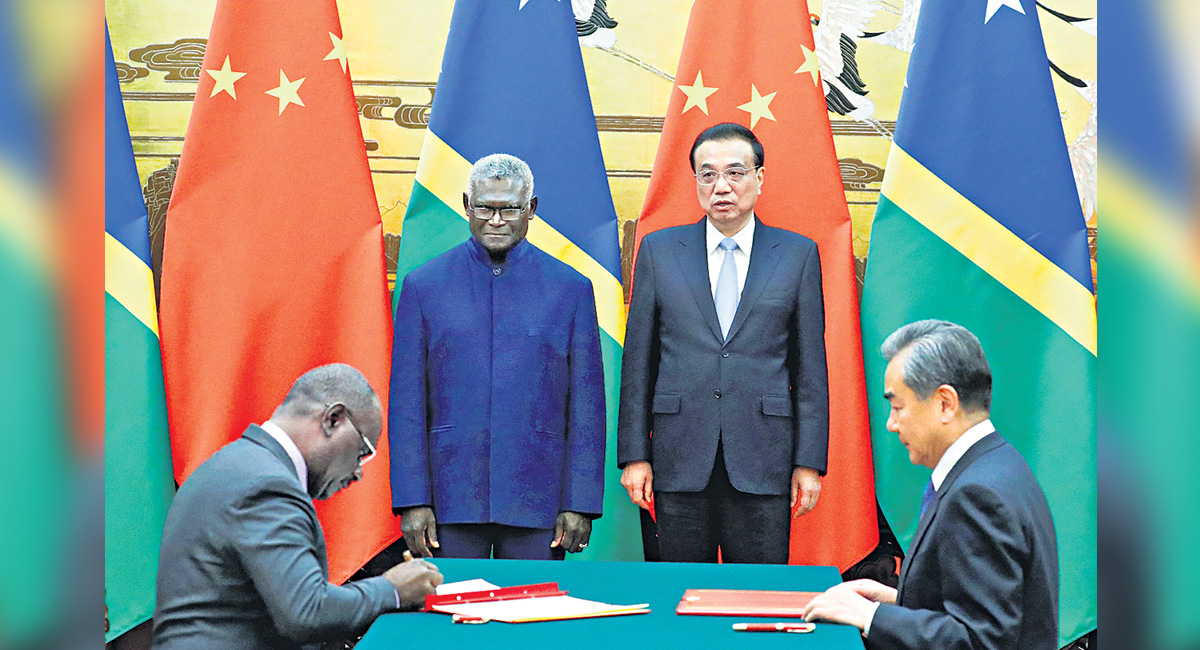
Published: Publish Date – 12:50 AM, Tue – 5 Jul 22

by Henryk Zadziewski
China’s interests in Pacific island nations have expanded over the past decade, from small diplomatic measures to doubling trade.
Now, in a world of increasing geopolitical instability and tensions over Taiwan, China is in a position to be a permanent partner for the region. China’s former ambassador to the US recently pointed to Australia treating the Pacific as a “backyard”, still stuck in the past, while China seeks more ‘modern’ relations with its neighbours.
soft diplomacy
What began for China as an economic relationship with investments in the fisheries and mining sectors has expanded to more comprehensive economic, security and diplomatic ties, especially after the announcement of the Belt and Road Initiative (BRI) in 2013. has gone. Beijing has also expanded its soft line. To provide education to Pacific Islanders in areas such as diplomacy, law, agriculture and journalism.
Before economic ties, there were historical ties. People of Chinese heritage have been present in the Pacific islands for more than 200 years, as traders, speculators, indentured laborers and political refugees migrated from the south and southeast of China.
Prior to 1975, most Pacific island countries formerly recognized Taiwan (or the Republic of China). But Fiji and Samoa became the first to develop diplomatic relations in 1975. Since then eight other regional states have switched from Taiwan and developed formal relations with Beijing: Papua New Guinea (1976), Vanuatu (1982), Federated States of Micronesia (1989), Cook Islands (1997), Tonga (1998), Niue (2007), Solomon Islands (2019) and Kiribati (2019).
South-South Cooperation
The Chinese government labels its growing presence as an expression of ‘South-South Cooperation’: a movement that prioritizes the transfer of knowledge, resources and technology between countries in the Global South. Chinese officials often accuse Western countries of being condescending to Pacific Islanders.
The move to state participation began at the Forum of Economic Development and Cooperation Leaders of the First Sino-Pacific Island Countries in Fiji in 2006. The assembly of senior politicians set a tone for economic cooperation through grants, loans and preferential trade.
The ‘Visit Diplomacy’ has been a key indicator of the Chinese state’s growing interest in the region. Since 2014, there have been 32 one-on-one meetings between Pacific government heads and Chinese President Xi Jinping – an unprecedented level of contact compared to Xi’s predecessors Jiang Zemin (1993–2003) and Hu Jintao (2003–2013). .
The 2014 meeting between Xi in Nadi, Fiji and political leaders of eight Pacific island countries was a notable event in Beijing’s expansion. Xi welcomed the dignitaries to “ride the Chinese ‘express train’ of development” under the BRI’s Maritime Silk Road. All of Beijing’s regional diplomatic partners have since signed the BRI MoU. Foreign direct investment also increased by 175% in the two years following the visit, of which 70% of the $2.8 billion was directed to PNG.
Chinese Foreign Minister Wang Yi’s visit to seven Pacific island states in May 2022 was the latest example of travel diplomacy – showing how China’s presence has gone beyond economic ties alone.
Wang proposed that China’s 10 diplomatic partners sign a multilateral “Common Development Vision” that includes law enforcement, fisheries planning, developing Internet capability, the new Confucius Institute, $2 million for COVID-19 relief, and 2,500 scholarships. Are included. The deal also proposes a Sino-Pacific Islands Free Trade Zone that would double the volume of bilateral trade from 2018 levels by 2025.
While the effort fell short due to reservations among the leaders, Wang secured 52 bilateral economic and security deals after the visit, cementing Beijing’s position as a regional partner.
Between 1950 and 2012, Oceania received about $1.8 billion in Chinese aid. In the latest available data between 2011 and 2018, China was the second largest aid donor to the Pacific region after Australia. More than two-thirds of the assistance disbursed was in the form of interest-free or concessional loans and the rest in the form of loans. Grants Fiji received almost a quarter of China’s regional aid, second only to PNG, which received 32%. Since then Chinese aid has declined from $2.9 billion in 2018 to $2.44 billion in 2019.
growing business
From 2000 to 2012, the year before the establishment of the BRI, the value of trade between China and its diplomatic Pacific partners increased from $248 million to $1.77 billion. The value of bilateral trade with Pacific Islands Forum members (excluding Australia and New Zealand) has nearly doubled, from $4.5 billion in 2012 to $8.6 billion in 2018. The Marshall Islands, PNG and Fiji are China’s top export destinations. Between 2012 and 2018, the number of Chinese tourists to Oceania increased from 55,000 to 225,000.
In the past 10 years, China has added two new diplomatic partners and maintains embassies in eight of the 10 countries with which it has formal relations (the Cook Islands and Niue are exceptions).
There are currently six Confucius Institutes in the Pacific, two in Fiji and one each in the Cook Islands, PNG, Samoa and Vanuatu. Suva, the capital of Fiji, is one of the world’s 20 China Cultural Centers – “places created to promote cooperation and communication … of a bridge for people around the world to become familiar with China.” Construction”. China has also expanded the availability of scholarships and training for students and journalists over the past 10 years.
As these relations grow and normalize, it is important to note that the Chinese presence is at the invitation of Pacific Islanders. It is affected by Pacific security concerns such as livelihoods and the climate crisis.
The April 2022 security agreement between the Solomon Islands and China, the exact details of which remain unknown, included the option for Honiara, the capital of the Solomon Islands, to request the presence of Chinese security forces to maintain social order and ensure security. it was done. Chinese personnel and projects. The purpose of protecting commercial interests was an indicator of how stable Chinese companies (state or private) had become in infrastructure development.
While some commentators have claimed that the agreement with the Solomon Islands could lead to the establishment of a People’s Liberation Army base, this comes after years of Chinese military and police aid through support and training.
As ‘traditional’ partners such as the United States and Australia re-evaluate Pacific policies to limit Chinese presence, they do so in a world where Pacific island nation governments are determined to shape their future in response to emerging geopolitical competition for influence. can determine.

(The author is a lecturer at the University of Hawaii at Manoa. 360info)